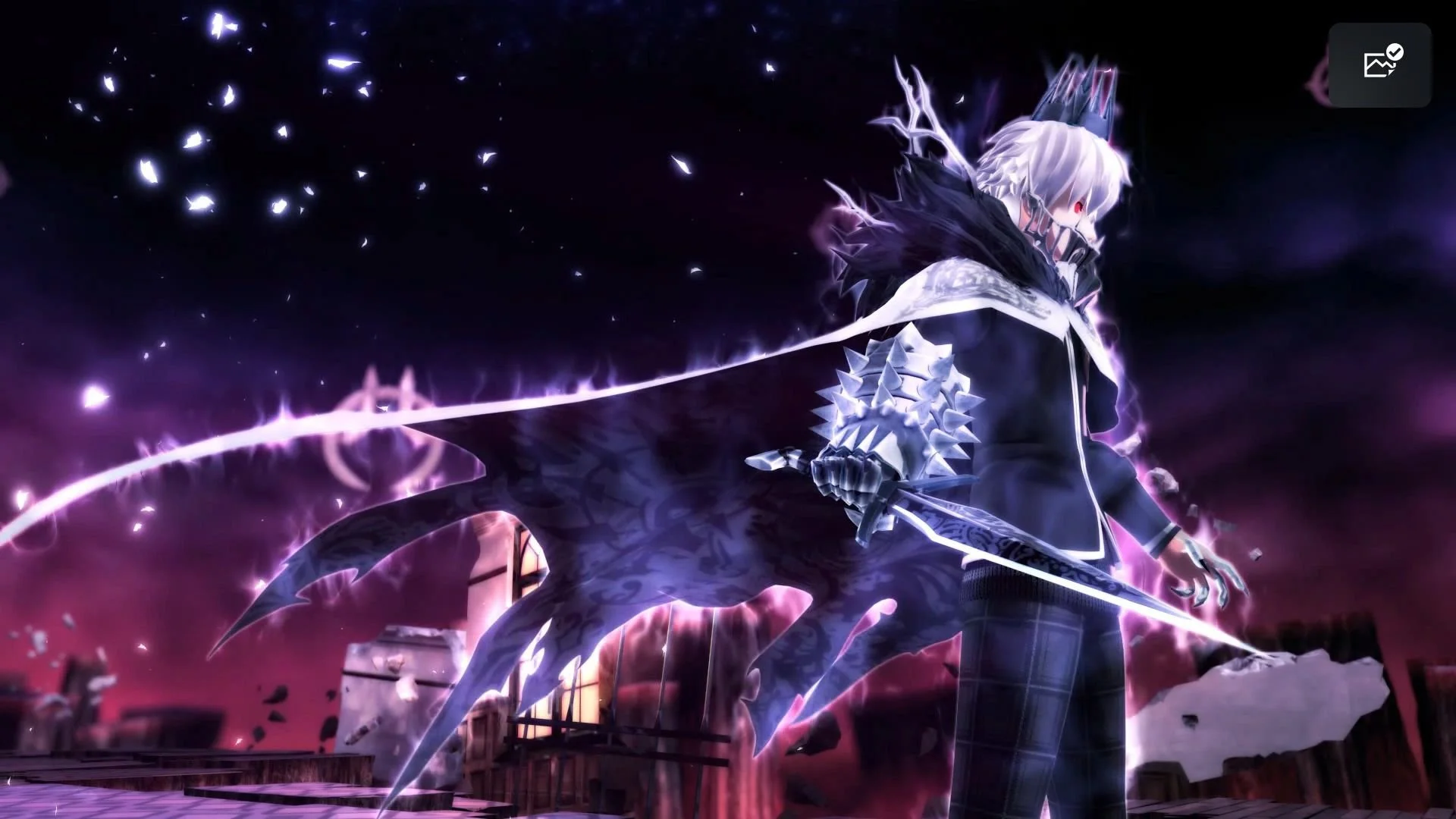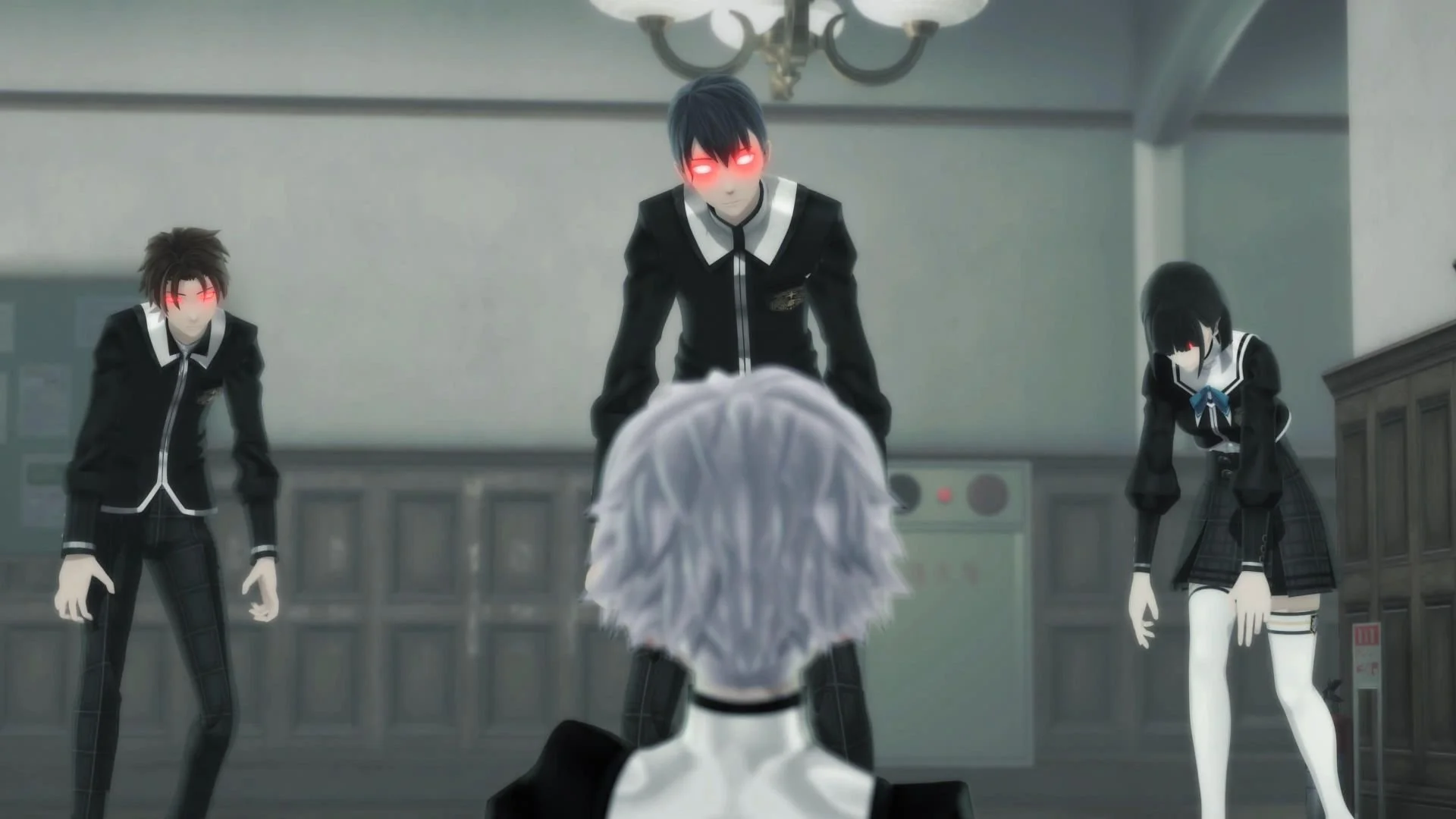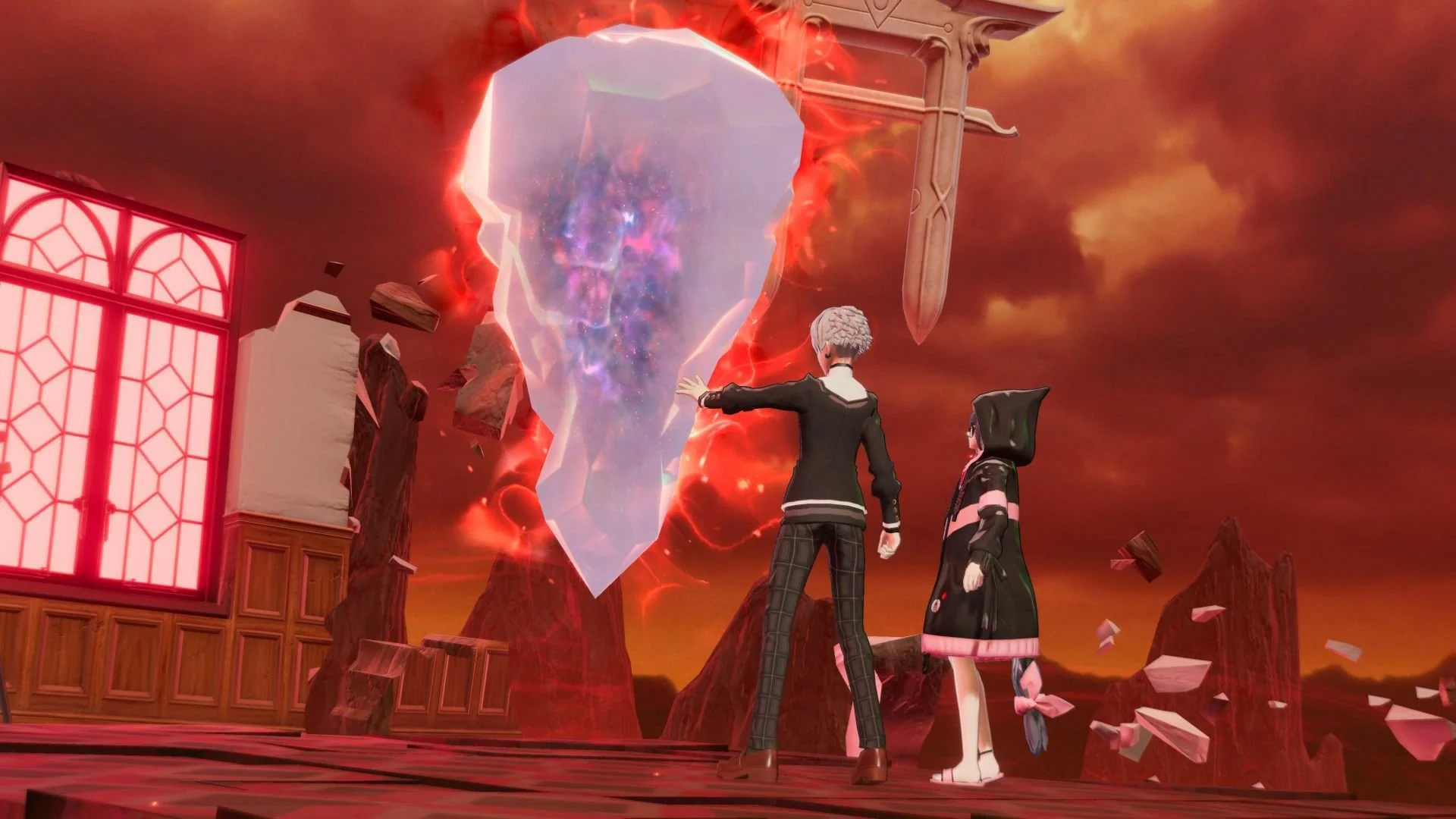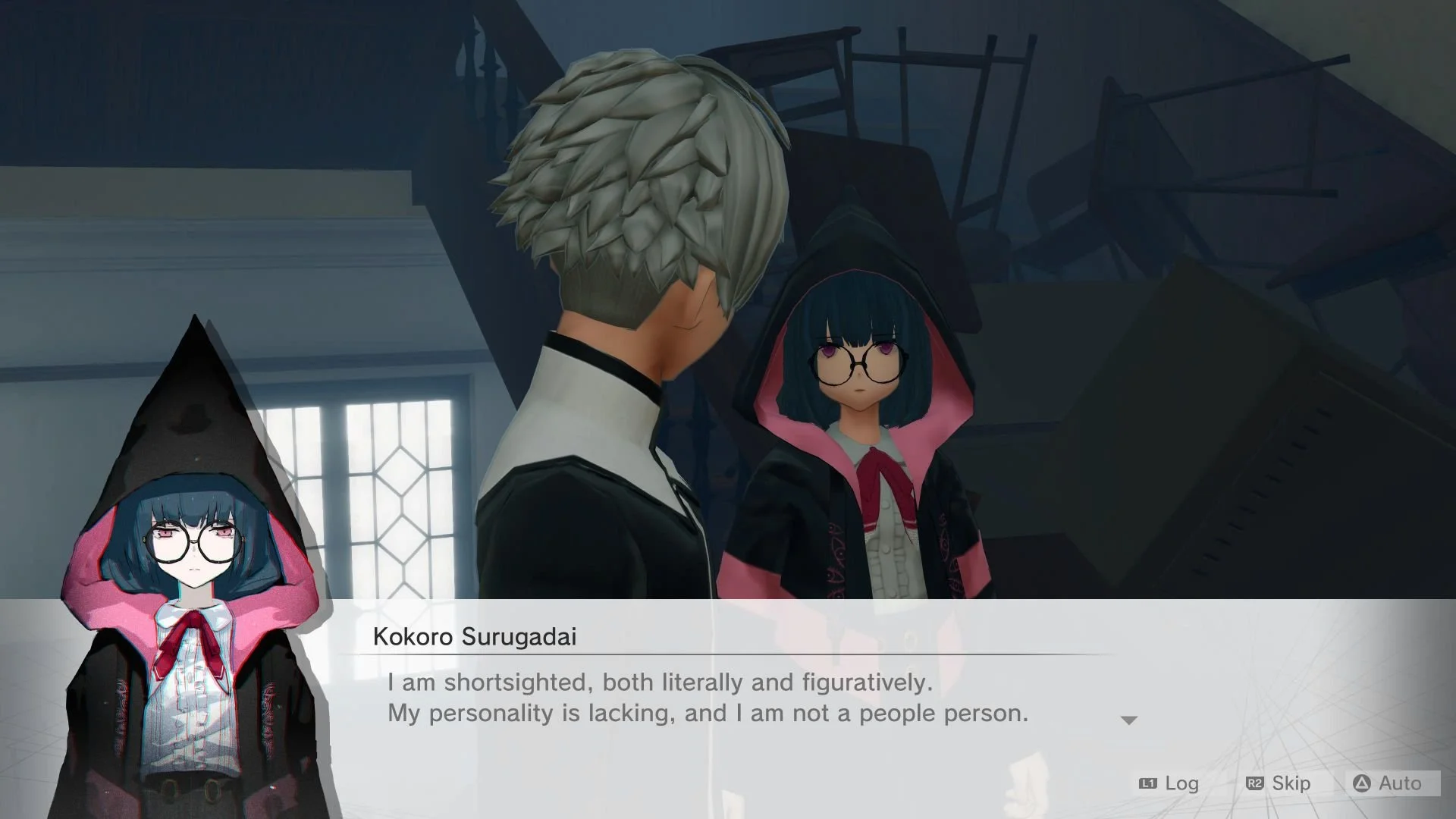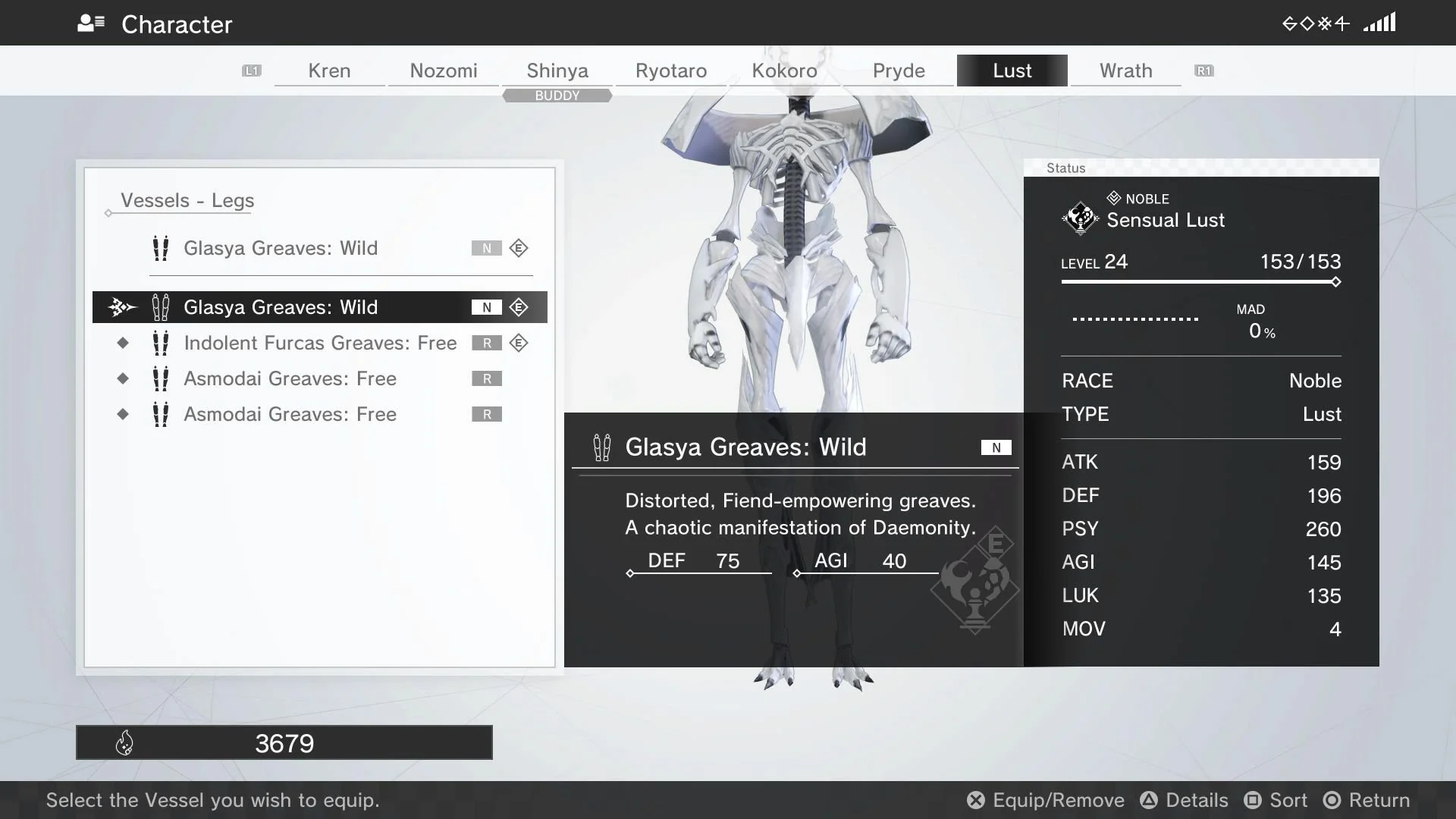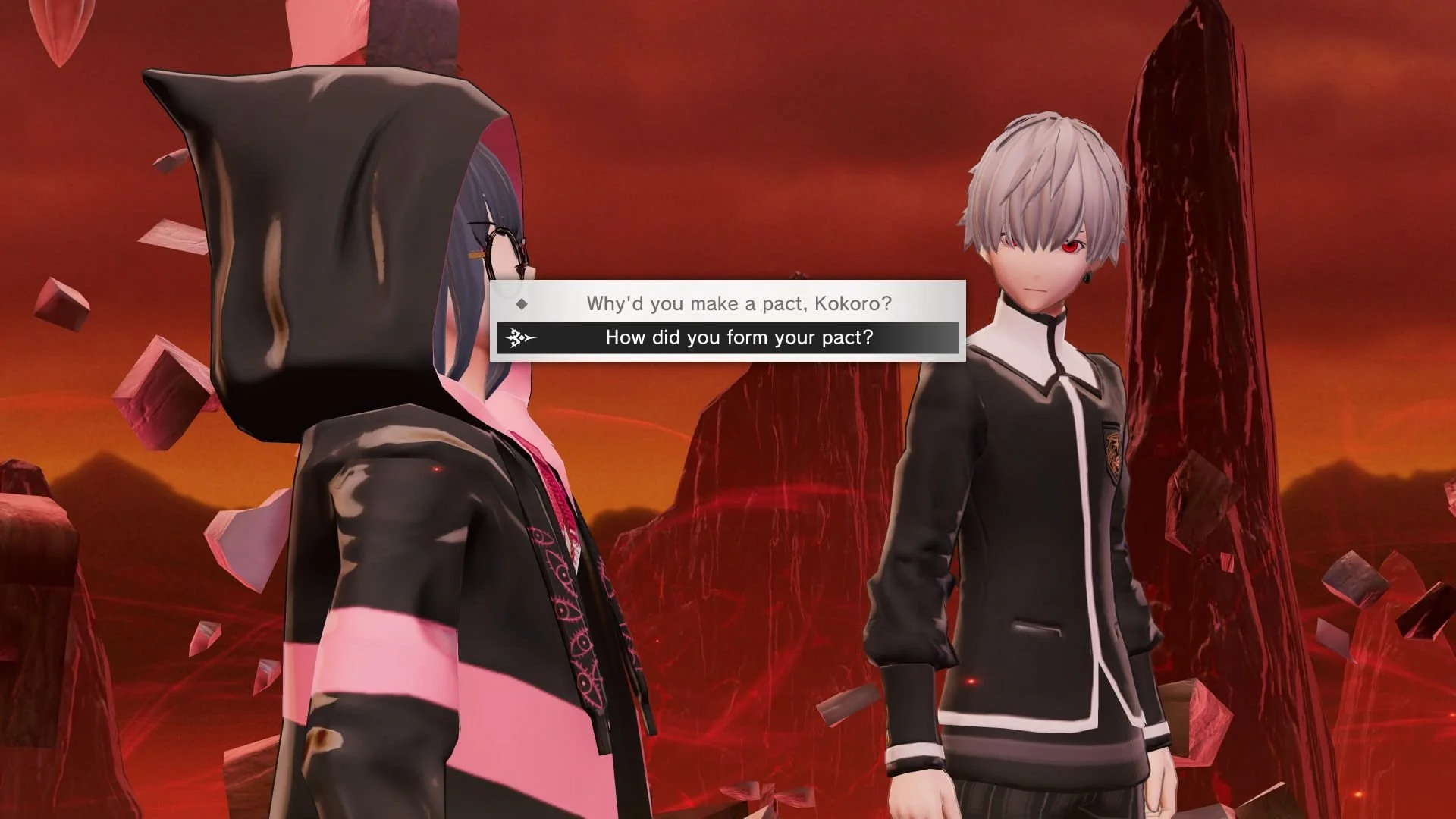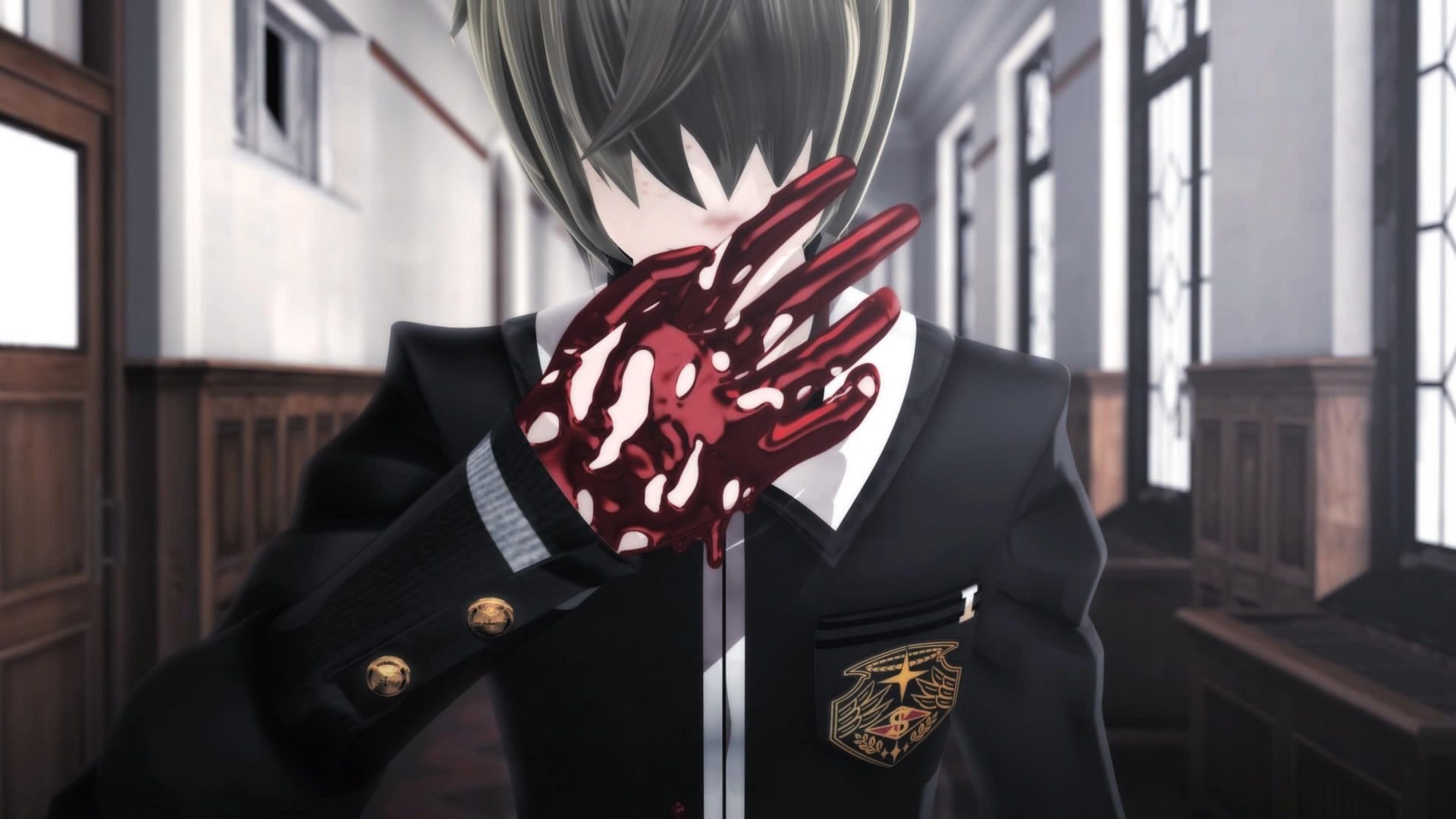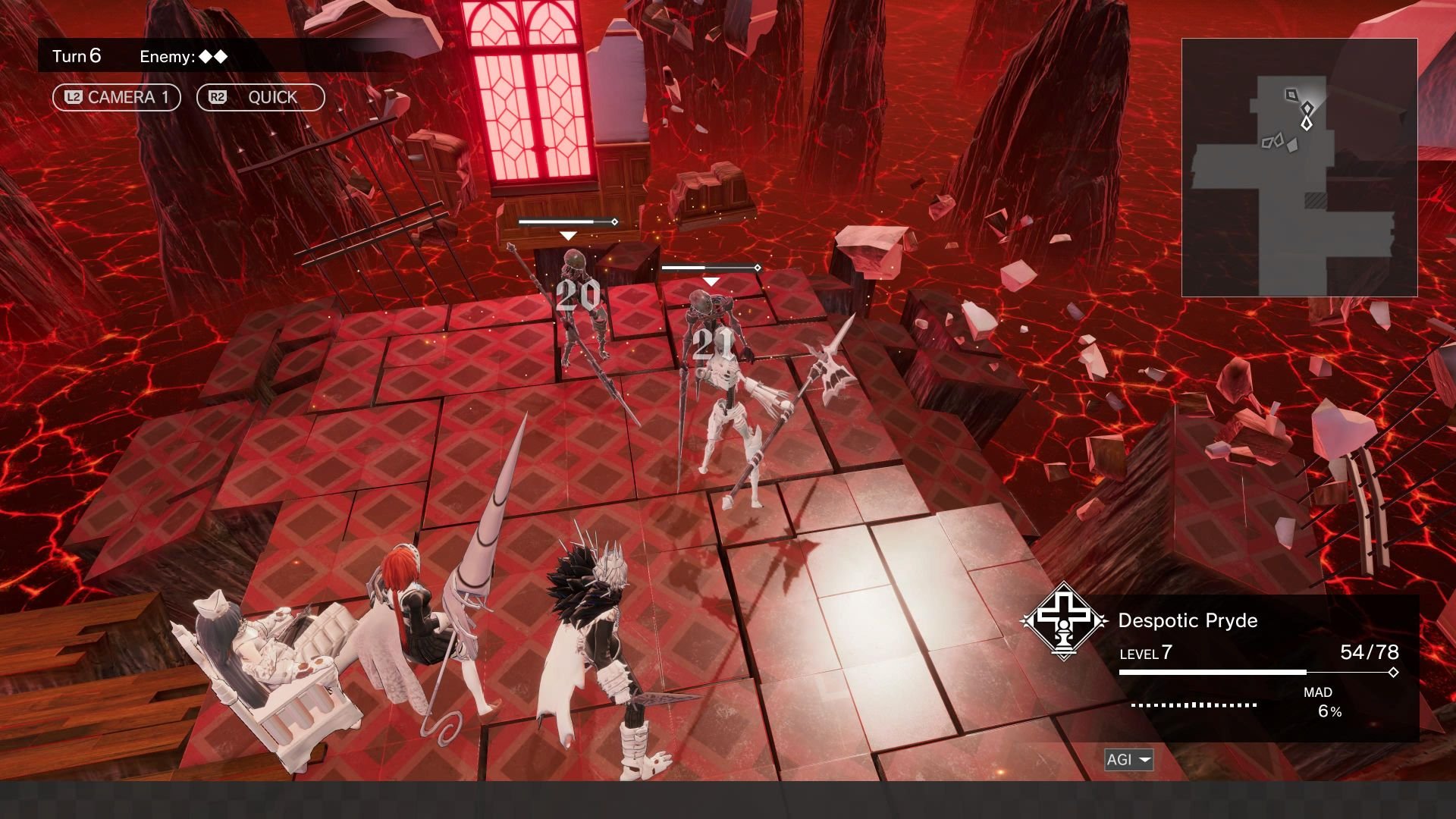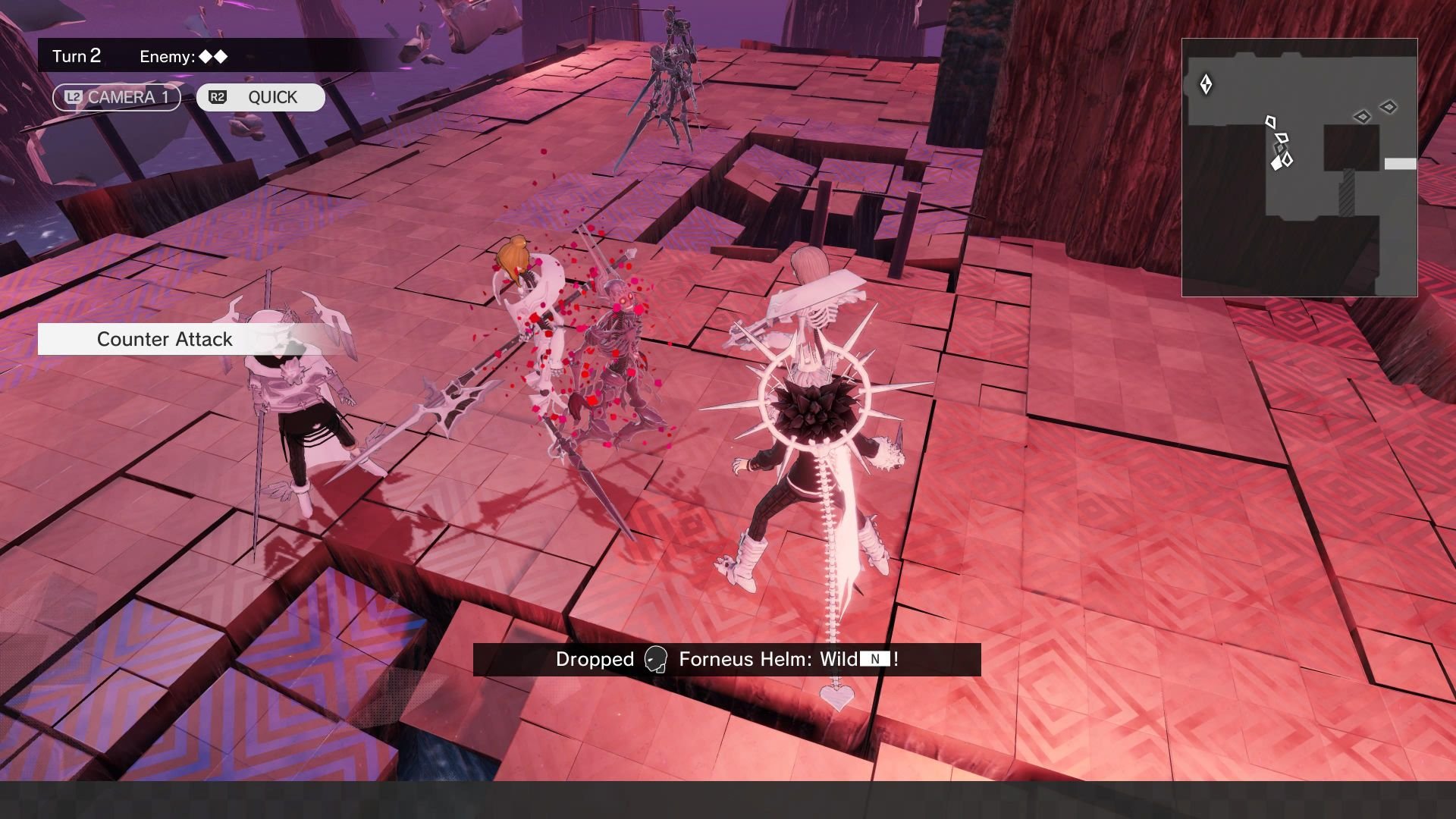The Bearer of sin.
Monark, a horror-aesthetic JPRG by some of the creative minds of the Shin Megami Tensei series, is certainly an interesting game that does more right than it does wrong. While it has a largely enjoyable narrative, punctuated with a solid overall cast and deep combat system, it can often feel undermined by an incredibly poor progression system that brings the grind to the forefront of the experience.
Set within the academic confines of the Shin Makado Academy in Japan, you play as an amnesia-stricken teenager granted mystical powers in order to stop a collective of trauma influenced individuals called Pactbearers, who are unknowingly using their powers to maintain a barrier around the school, trapping its students and faculty within. Much of the backstory and lore is front-loaded pretty early and often, and one of its lore-givers, a supernatural rabbit plush named Vanitas, complicates matters as they only speak in cryptic rhymes, making some of its information needlessly convoluted.
Your main protagonist, along with a few individuals, makes up what is called the New Student Council, and to those around you, you are called VP, or Vice President. This council is created to get to the bottom of defeating the Pactbearers and saving the school. These Pactbearers are those who have struck some sort of deal with demonic entities known as Monarks and gifted supernatural powers to ensure their wishes come true. Each Pactbearer is reached by destroying the foundation of their Pact. These come in the form of three crystalized ideals, each destroyed in a combat encounter leading up to their confrontation. This pattern lends itself to the majority of the game and often makes each new area a bit too repetitive for its own good.
The game breaks up its chapters by focusing on each Pactbearer, and most of the game is structured around visiting a new location, destroying the ideals, and then dealing with the Pactbearer and their Monark. While it does eventually present a twist that changes the remainder of the game, at least in some ways, this format is very constant and doesn't always lend itself to remaining entertaining. Each location will have a variety of puzzles, but most of them will feel like you are guessing at its solution more so than coming at it with full confidence. This is most relevant in having to search through your profiles and lore entries, looking for numbers or phrases to unlock safes, or logging into school computers for blackmail or information to move a character that is impeding your progress. These puzzles never feel satisfying and often ruin any pacing the story is urgently trying to convey as you are pulling up various bits of information around the brief clues you are given.
Monark's story and characters are often compelling enough to just border on being engaging, but you rarely get enough time to really dive into its cast apart from story moments where that information is forced upon you. Each chapter will see you touring the Academy with a single Pactbearer at your side, sidelining a previous companion to the Student Council room for no significant reason other than claiming they are busy. This limits a great deal of time you'll have with them, and often results in them falling behind in levels as you'll want to focus on making your current party up to the level needed to remain competitive. While I did enjoy the story overall, there are times where the game doesn't quite swing for the fences and your mileage on it will vary, though, I will say that one of your companions, Kokoro Surugadai, was an absolute delight and her story-arc really made me care about her and her journey alongside the main protagonist.
What is rather impressive from a narrative angle is that Kokoro Surugadai and Ryotaro Date, who are two of your companions, are also Pactbearers, meaning that, at some point, you'll need to contend with their ideals, and subsequently, their Monarks as well. This certainty makes late-game moments really stand out, even if not all the story beats really land or are paced in a way where you'll remain excited. You do have two additional companions in the form of Nozomi Hinata and Shinya Yuda, but despite having powers and motives of their own, they are not Pactbearers, and yet find their own footing in keeping up from a combat perspective, and towards the main story. The supporting cast is more or less alright, but one such character, who is probably the least interesting of the entire cast, gets a lot to do later on that can almost feel out of place despite their status in the game being elevated to do finally doing some really cool shit.
Joining your party will also be Fiends, a physical presence that is based on one of the seven deadly sins. These blank slates of a companion are skeletal in nature and bring with them various weapons, attacks, and playstyles. You can customize them, upgrade them, but they can be resource sink when you are already struggling to keep your party levels up appropriately, as they come to your party at level one. Often, I had to mostly ignore any additional ones given to me as I rather would devote my time to my established team that I was already investing my time and Spirit points into.
As you enter into new zones, covered in a mist that is driving its occupants mad, you yourself will start to feel the pull, seeing a madness meter increase as you spend more time running around its halls, dodging crazed students as they try to rush you. While the madness mechanic has a place in combat, which I'll dive into shortly, it feels pointless here as you can simply fast travel to the Infirmary, revert it back to zero, and then fast travel back, removing the madness built up and making the mechanic feel more like an annoyance than anything that feels fruitful in its execution.
Upon entering into new areas, you'll initially receive a “Death Call” on your phone, which is the way you'll enter the Otherworld for every combat encounter. These calls can be sidelined easily as you take part in a specialized battle that Vanitas has prepared for you, complete with hearing his same repeated line of dialogue each and every time. Answering the Death Call; however, before that battle, will take you to an encounter you are vastly underpowered for, so it's a mechanic I never saw the point of when my enemies had 200x more health than I did.
Battles in the Otherworld can be enjoyable, but a lot of combat falls into following the same strategy again and again. Each location in the Otherworld takes place in very samey environments, usually different in color, layout, but the function of them are all the same. There will be walls blocking enemies that can be broken to reach them, or the inclusion of hazards that can cause damaging effects such as a character being charmed or induced bleeding, or positive effects such as granting a small but welcome heal. Enemies can be affected by these as well, and since the A.I. is largely stupid, they often will stand next to them, giving you some cheap shots or allowing you to bottleneck them down certain paths, causing those hazards to do a lot of the dirty work for you.
Combat is turn-based with characters being able to move within a circled area that makes up their moveable range. If allies are close to your attacks, they may assist in dishing out damage, but this is not constant across all moves. Still, when it happens, you can destroy most foes when your whole team or at least another ally can almost wipe out an enemy in a single turn together. Some enemies will hit hard and battles only “game over” if you lose your main protagonist, so you'll want to ensure you don't allow them to get surrounded as, depending on your level, can often result in dying pretty damn quick. In fact, even if you are leveled around the same as most bosses, they can nearly one-shot you.
The overall flow of combat works through a few systems that I do wish were rolled out better but it won’t take you too long to get the hang of things. Characters can, more or less, attack through martial techniques called Arts that require HP to use, or Authorities, which raise your madness percentage depending on their effect. Both your Pactbearers or Fiends have access to these combat systems, so there is a balancing act required to get the most out of combat as the approach here is very much a risk and reward structure. This also causes the assist attacks to be that much more crucial to put down your enemy quickly. Some Arts and Authorities only strike one foe within a range, whereas some can result in multiple foes being hit at once, adding more strategy to the battle. Some attacks will result in the enemy countering, so you’ll want to attack from behind, or use an attack with greater range to prevent such an occurrence.
If you know that a character who has already taken their turn would be more effective against a remaining foe, you can defer your current character’s turn back to that character and have them attack again instead. However, this will increase their madness gauge, so while that option is present, it can be a gamble, especially if they miss. In fact, I once lost an hour-long boss encounter because of one single missed attack, so, you’ll want to make sure you plan for that to possibly happen. You can also link characters together through a system called Resonance, where you can share status ailments, buffs, and debuffs. Resonance will only last for a set number of turns, but it can prove crucial if you play it correctly.
Adding even more to the mix are Awakened attacks and how you can take advantage of your madness gauge. Awakened attacks are essentially special attacks, and while you’ll see a buff to all stats, it also allows you to use all Arts and Authorities at no cost. You can build this meter up by taking damage or ending your turn by using a skill called Resolve. Madness; however, is very different. When a unit reaches 100% madness, they will become uncontrollable, and after three turns, they will die, resulting in a game over if your main character is the one who has reached full madness. During this status effect, defense will decrease, but all other stats are buffed. If both Awakened and Madness are at max, you’ll enter a state of Enlightenment, and see greatly increase stats for three turns, and much like being Awakened, you can use all Arts and Authorities at no cost.
As I’ve mentioned, combat is largely fun, but since most attacks and mechanics work in certain ways, it is very easy to fall into a repetitive loop of performing the same actions, the same strategies due to their effectiveness. I found that I would start combat encounters using the same opening moves, and since you’ll repeat a lot of the game to grind away leveling, there is a solid amount of repetition here that can cause combat to become a bit too routine. You do have an assortment of items to use as well, with stabilizers to lower your madness gauge or items to heal, but I do wish that items were quantity sorted as scrolling through a list of 42 identical healing items and then 30 items to cure charmed, and then 20 more that cure disable simply to find something to heal poison can be a bit much.
The biggest offender to repetition here; however, is the incredibly poor progression system that is built around grinding away at previously conquered battles to level up you and your companions. As you battle, you’ll earn Spirit and while you can use it to buy items, its primary use is leveling and unlocking skills for each character. The biggest issue is that this currency is shared from one single pool. So, if you get a new character or Fiend added to your party, you’ll be taking away Spirit from those you are trying to level up should you invest Spirit into them. It is worth pointing out that this is the ONLY way to increase their level. Most battles after a while will grant you a few thousand Spirt for each encounter, but it can take that amount just to unlock one new move or upgrade for a single character. Each skill can be upgraded and each use of Spirit will also boost their core stats, leveling them up. Had Spirit NOT been shared and each total was given to each character separately, then Monark would have no grind to speak of, but could result in a shorter game. Still, I’d rather take the former if it meant a more satisfying experience as I spent nearly 52 hours with Monark, and while I could grind another 30 hours to unlock the true ending, nearly 15-20 hours of my time here was just grinding, often dumping 3-4 hours on a new character just to catch them up to my team’s current level.
Aesthetically, Monark has a very cool look, but from a technical angle, this looks very much like a game where its Switch version was the lead platform and PS4 and PS5 are merely seeing cleaner textures and a boosted resolution. Monark’s characters are vastly too simple, and it’s a shame since the cutscene versions of them are fantastic, and simple enough that I wish those models were used for its gameplay. This lack of detail is really noticeable in their faces as they simply look far too plain. While some of its standard enemies are mostly disappointing, the bosses themselves are incredibly cool and look stunning from top to bottom. Environments also have a very copy and pasted approach to almost all its locations, but towards the back half of the game, the game gets considerably better at giving us new locations and variety, but until then, get used to the same hallways and same visual approach to its Otherworld.
One of the best things this game offers is that nearly everything here is voiced, and while your character does talk in some instances, it’s a shame their own story dialogue wasn’t voiced as they clearly had a lead actor present. However, hearing the entire cast talk gives even the flattest characters a range that is boosted here due to some fairly decent voicing acting, especially that of Kokoro Surugadai, who is so damn impressive here that she might be one of my favorite JRPG characters of all time. Her story was pretty damn enjoyable, but her English actress really sells her emotional state and made me really care about her. Additionally, while the overall music is fairly forgettable, the tracks featured during the boss encounters are extremely solid, and I often would just pause on my turn and listen to the music.
Monark has a lot of interesting twists and turns and character moments that really stand out. I think the horror elements are handled well enough, and combat certainly can be an entertaining experience if you can manage the grind and maybe drown it out with a podcast or some other type of distraction. I would have preferred the game to have been shorter and its Spirit earns more efficient for each character to lessen the grind that did impact my overall experience. I do believe there is a solid game here, but my recommendation comes with the added caveat of its grind, as despite how enjoyable of a game there is here to take part in, its repetition is the game’s biggest sin of all.
Developer - FuRyu, Lancarse. Publisher - FuRyu, Nippon Ichi Software, NIS America. Released - February 22nd, 2022. Available On - PlayStation 4/5, Nintendo Switch, Windows. Rated - (T) Blood, Language, Suggestive Themes, Violence. Platform Reviewed - PlayStation 5. Review Access - A review code was provided by the publisher for the purpose of this review.
0 Likes


